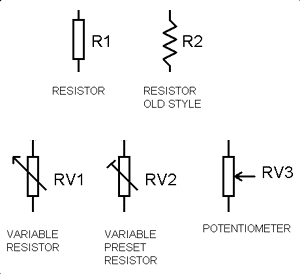
|
|
||
Resistors Resistors are one of the simplest of circuit components. They are made from a variety of materials using various techniques ranging from wirewound devices for high power low frequency application to metal film for low power uses and when close tolerances and high stability are required. Circuit Symbols
|
|||||||||||||||
|
Resistors are so called because they restrict the flow of current through a circuit. The relationship between a resistors value, voltage and current is given by Ohm's Law. V = I R In normal operation a resistor will heat up due to the current passing through it. The power dissipated in a resistor is given by: P = V I = V2 /
R = I2 R
|
|||||||||||||||
|
Component marking Component values are marked either as text as on large wirewound components. For example 100W 5% 3W would indicate a 100 ohm resistor with 5% tolerance (95 - 105 ohms) with a power rating of 3 watts. The markings 1k2 1% 0W25 would indicate 1.2 kilo-ohms (1200 ohms) with a 1% tolerance rated at 1/4 of a watt. On some resistors especially very small parts, like those used in surface mount only the value is given as a code such as 473, The last digit is a multiplier and is the number of zeros to be added to the first two digits to make the value, in this case 47000 or 47 kilo-ohms. The other method of marking is by using coloured bands on the body of axial leaded components as shown in the resistor colour code chart.
Resistors can be connected in a number of combinations to obtain non-standard values. The most common arrangements are: Series Connection
|
|||||||||||||||
|
Parallel connection
|
|||||||||||||||
|
A typical use for resistors is a voltage divider
This principle is used in a volume control, where a potentiometer (or pot) is used. |
|||||||||||||||
















